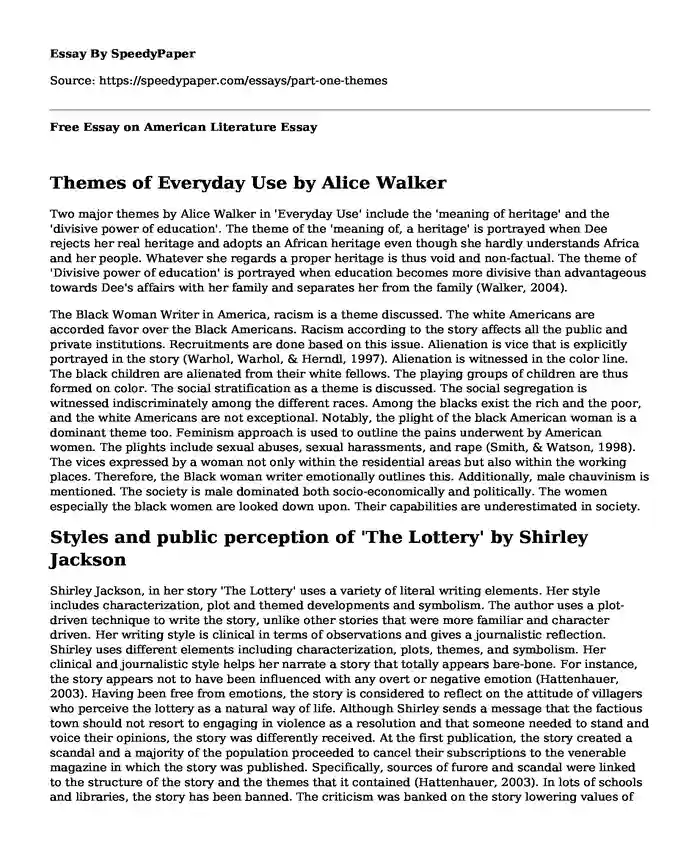
| Type of paper: | Essay |
| Categories: | Shirley Jackson Alice Walker |
| Pages: | 3 |
| Wordcount: | 649 words |
Themes of Everyday Use by Alice Walker
Two major themes by Alice Walker in 'Everyday Use' include the 'meaning of heritage' and the 'divisive power of education'. The theme of the 'meaning of, a heritage' is portrayed when Dee rejects her real heritage and adopts an African heritage even though she hardly understands Africa and her people. Whatever she regards a proper heritage is thus void and non-factual. The theme of 'Divisive power of education' is portrayed when education becomes more divisive than advantageous towards Dee's affairs with her family and separates her from the family (Walker, 2004).
The Black Woman Writer in America, racism is a theme discussed. The white Americans are accorded favor over the Black Americans. Racism according to the story affects all the public and private institutions. Recruitments are done based on this issue. Alienation is vice that is explicitly portrayed in the story (Warhol, Warhol, & Herndl, 1997). Alienation is witnessed in the color line. The black children are alienated from their white fellows. The playing groups of children are thus formed on color. The social stratification as a theme is discussed. The social segregation is witnessed indiscriminately among the different races. Among the blacks exist the rich and the poor, and the white Americans are not exceptional. Notably, the plight of the black American woman is a dominant theme too. Feminism approach is used to outline the pains underwent by American women. The plights include sexual abuses, sexual harassments, and rape (Smith, & Watson, 1998). The vices expressed by a woman not only within the residential areas but also within the working places. Therefore, the Black woman writer emotionally outlines this. Additionally, male chauvinism is mentioned. The society is male dominated both socio-economically and politically. The women especially the black women are looked down upon. Their capabilities are underestimated in society.
Styles and public perception of 'The Lottery' by Shirley Jackson
Shirley Jackson, in her story 'The Lottery' uses a variety of literal writing elements. Her style includes characterization, plot and themed developments and symbolism. The author uses a plot-driven technique to write the story, unlike other stories that were more familiar and character driven. Her writing style is clinical in terms of observations and gives a journalistic reflection. Shirley uses different elements including characterization, plots, themes, and symbolism. Her clinical and journalistic style helps her narrate a story that totally appears bare-bone. For instance, the story appears not to have been influenced with any overt or negative emotion (Hattenhauer, 2003). Having been free from emotions, the story is considered to reflect on the attitude of villagers who perceive the lottery as a natural way of life. Although Shirley sends a message that the factious town should not resort to engaging in violence as a resolution and that someone needed to stand and voice their opinions, the story was differently received. At the first publication, the story created a scandal and a majority of the population proceeded to cancel their subscriptions to the venerable magazine in which the story was published. Specifically, sources of furore and scandal were linked to the structure of the story and the themes that it contained (Hattenhauer, 2003). In lots of schools and libraries, the story has been banned. The criticism was banked on the story lowering values of American towns. A majority were against allegations that the writer highlighted in relation to the regular stoning of persons to death. The reaction came as shock to the author since her aim was to pint out inhumanity that existed; a point that was negatively perceived by the public.
Reference
Hattenhauer, D. (2003). Shirley Jackson's American Gothic. SUNY Press.
Smith, S., & Watson, J. (Eds.). (1998). Women, autobiography, theory: A reader. Univ of Wisconsin Press.
Walker, A. (2004). Everyday use. Recording for the Blind & Dyslexic.
Warhol, R. R., Warhol-Down, R., & Herndl, D. P. (Eds.). (1997). Feminisms: an anthology of literary theory and criticism. Rutgers University Press.
Cite this page
Free Essay on American Literature. (2022, Feb 21). Retrieved from https://speedypaper.com/essays/part-one-themes
Request Removal
If you are the original author of this essay and no longer wish to have it published on the SpeedyPaper website, please click below to request its removal:
- Internship Cover Letter - Free Sample
- Free Essay on Indigenous People of Canada and Aboriginal Rights
- Essay Sample on Criminal Law Special Interest Influences
- Free Essay with a Discussion on Type 2 Diabetes in the United States
- Free Essay Comprising a Business Management Article Review
- Free Essay Example: Personal Connectivity Milestones
- Essay Sample on Role of Risk Assessment
Popular categories




